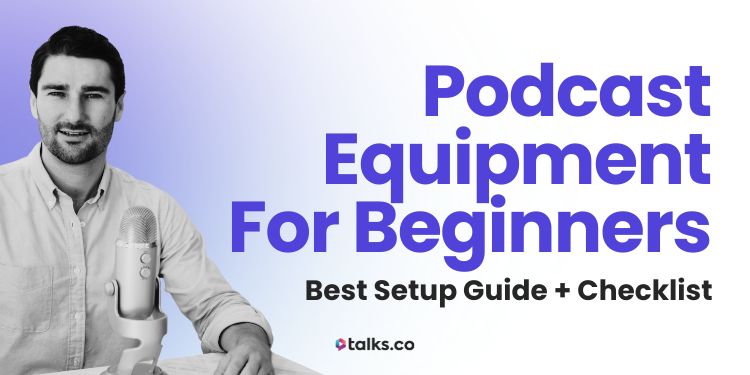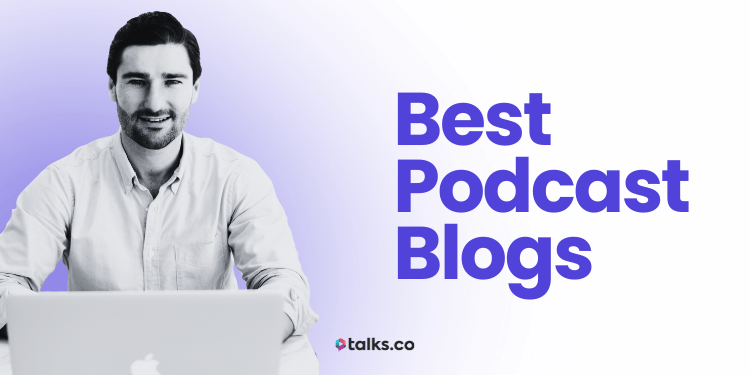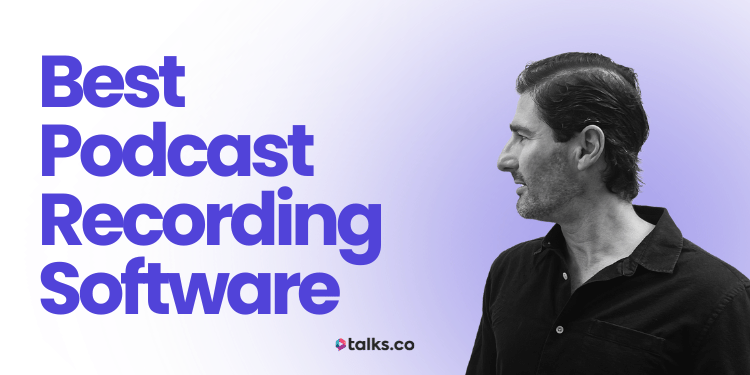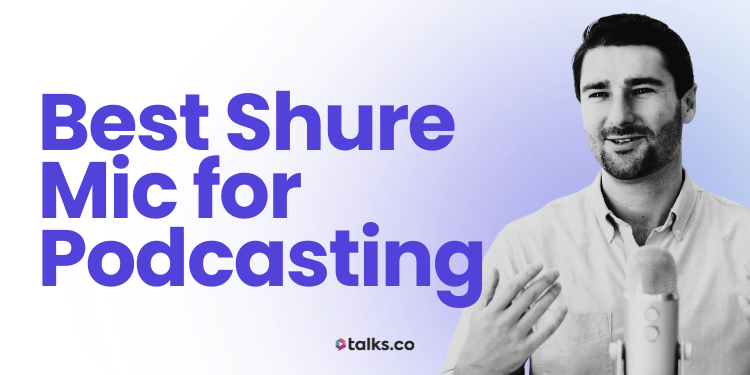Wondering what podcast gear you actually need to start a podcast and what’s just extra?
You don’t need an expensive podcast studio to sound sharp. But you do need a podcast equipment setup that works, sounds clean, and doesn’t make recording a chore.
When I started recording podcast interviews and guesting on podcasts, I had no clue what podcast equipment for beginners was worth the money.
Mixer? Recorder? Just my phone?
And trust me, I’ve tried it all. Portable kits while traveling, remote setups from beach towns, full interview rigs at home. After hundreds of recordings, I know what podcast setup is worth it and what’s not.
If you’re a coach, expert, or entrepreneur ready to get your voice out there, this podcast starter kit guide is for you.
I’ll walk you through exactly what podcast equipment for beginners you need, what each piece does, and which options make sense based on your setup and budget.
Let’s build your kit.
What Equipment Is Needed for a Podcast?
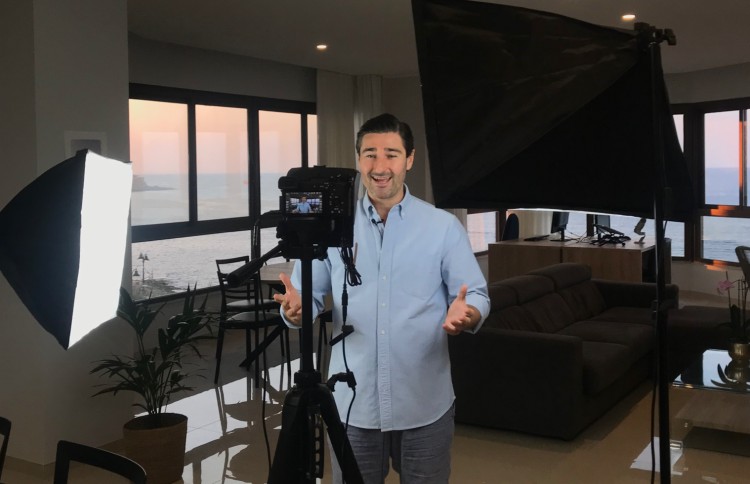
Before you start buying podcasting equipment, it helps to get clear on what you actually need as a podcast host to launch a podcast and what can wait.
Here’s a clean breakdown of the essential podcasting equipment.
What basic equipment do you need for a podcast?
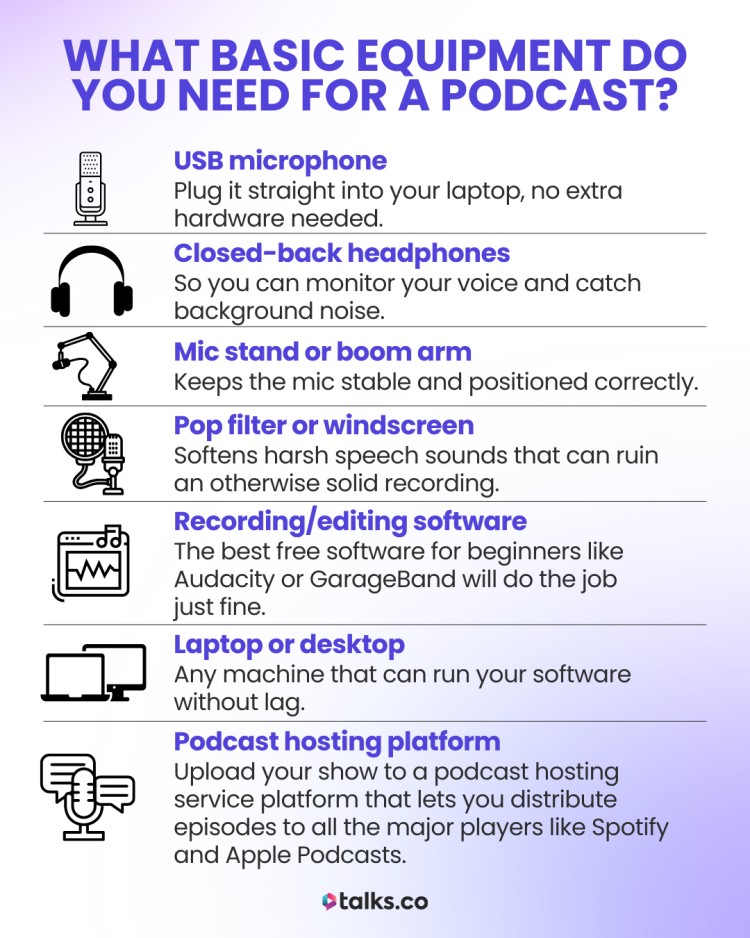
Before buying gear for your digital audio workstation, here’s a clean breakdown of the essential podcast equipment:
- USB microphone: Plug it straight into your laptop, no extra hardware needed.
- Closed-back headphones: So you can monitor your voice and catch background noise.
- Mic stand or boom arm: Keeps the mic stable and positioned correctly.
- Pop filter or windscreen: Softens harsh speech sounds that can ruin an otherwise solid recording.
- Recording/editing software: The best free software for beginners like Audacity or GarageBand will do the job just fine.
- Laptop or desktop: Any machine that can run your software without lag. (Check this out for the best laptop options for podcasting.)
- Podcast hosting platform: Upload your show to a podcast hosting service platform that lets you distribute episodes to all the major players like Spotify and Apple Podcasts.
Start your first podcast with a simple budget podcast setup and build with professional equipment as you grow.
Types of podcast equipment
Here’s a quick overview of audio equipment and gear categories and when you need them:
- Microphone: Capture your voice, the most important piece of equipment when setting up your podcast.
- Audio interface: Needed if you use XLR mics to convert analog to digital.
- Podcast mixer: Control volume and mix live, ideal for multi-person shows to enhance your podcast.
- Headphones: Monitor audio quality while recording and editing.
- Recording device: Save podcast audio without a computer, great for mobile setups.
- Acoustic treatment: Foam panels or rugs to reduce echo.
- Mic stand or boom arm: Holds your mic steady and in place.
- Cameras and lighting: Optional equipment choices if you’re recording video podcasts.
What to consider before buying podcast equipment
Before you grab gear off a “top podcast mic” list, step back and figure out what kind of podcast setup actually makes sense for your show. It’s not just about specs, it’s about how you’ll use it.
Before you start podcasting, ask yourself:
- Who’s on the mic? If it’s just you, keep it simple. If you’ve got guests or co-hosts, you’ll need gear that supports multiple inputs.
- Will you be on video? That changes everything. Features like lighting, camera angles, and how your space looks all start to matter.
- What’s your recording environment like? If your room has echo or background noise, you’ll want gear that minimizes that without needing soundproof walls.
- How mobile is your setup? Working from coffee shops or co-working spaces? Go for quality equipment and compact gear that packs light and sets up fast.
- What’s your tech comfort level? Some setups are plug-and-go. Others take some tinkering. Don’t grab a complex mixer if you’re not really into tech.
Thinking this through now saves you time (and returns) later.
What makes great podcast equipment?
It’s not about chasing the most expensive and popular podcast mic or the biggest professional podcast setup. The best podcast equipment for beginners does three things well:
- Captures your voice clearly without needing perfect mic technique or a soundproof room.
- Works consistently without mystery glitches, random buzzing, or guessing which cable goes where.
- Fits how you record a podcast whether that’s remote interviews, solo episodes, in-person chats, or quick hits recorded on the go.
Best Podcast Equipment for Beginners
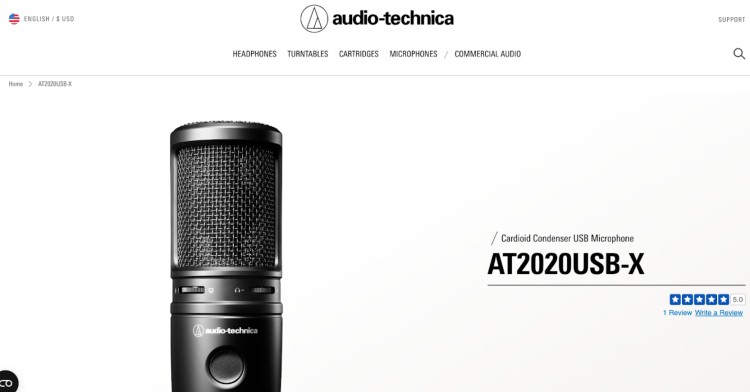
When you’re starting a new podcast, go for gear that’s reliable, easy to use, and actually sounds good. Here are beginner-friendly options that tick all the right boxes:
- Audio-Technica AT2020USB-X: USB mic with headphone jack for monitoring.
- Sony MDR-7506 Headphones: One of the best podcast headphones out there. It’s closed-back for detailed sound. Comfy enough for long recording sessions.
- Rode PSA1+ Boom Arm: Flexible, quiet, and doesn’t take up desk space.
- OnStage Pop Filter: Basic but effective in reducing harsh plosives.
- GarageBand (Mac) or Ocenaudio (Windows): Free, beginner-friendly software.
Podcast microphone for beginners
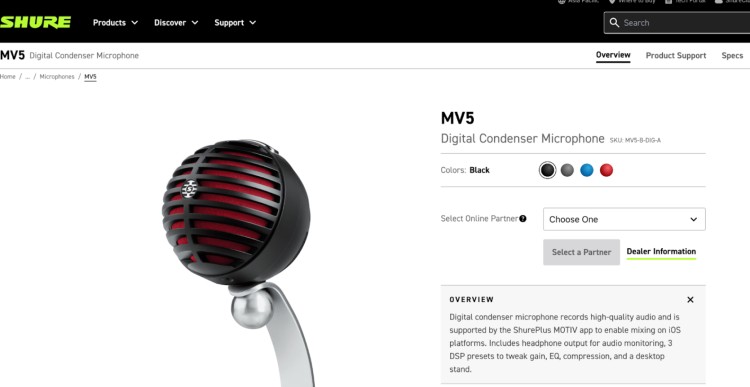
Your mic is doing the heavy lifting, so don’t treat it like an afterthought. But that doesn’t mean you need a full studio rig to sound professional.
If you’re starting out and ready to invest in something solid, the Shure MV5 is a no-brainer. It’s portable, easy to set up, and sounds great right out of the box for all types of podcasts.
Here’s why it works for beginners:
- USB and Lightning compatible: Works with Mac, PC, and iPhones. No adapter stress.
- Built-in presets: Switch between voice, instrument, and flat modes depending on what you’re recording.
- Real-time monitoring: Plug headphones directly into the mic so you can hear yourself clearly while recording.
- Compact design: Desk-friendly and travel-ready without sacrificing quality.
- Zero setup required: No software to install, no interface needed. Just plug in and hit record.
- Shure quality: Crisp, clear sound from a brand trusted by professionals.
Podcast equipment kit for beginners
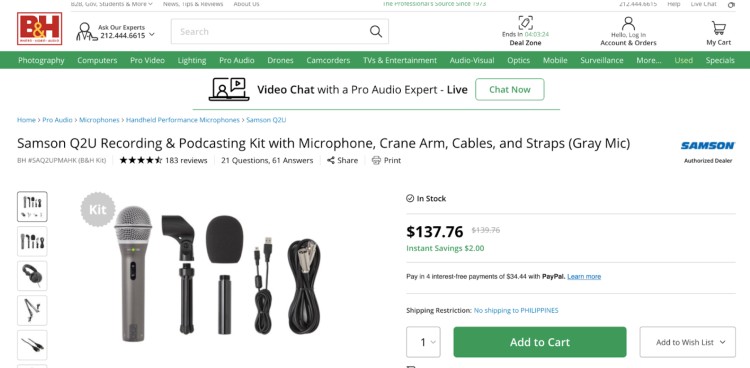
The Samson Q2U Recording and Podcasting Pack is one of the best podcast starter kits for beginners who want quality without the fuss.
What’s in the box:
- Samson Q2U mic (USB/XLR dual output)
- Desktop tripod stand
- Foam windscreen
- USB and XLR cables
- Closed-back headphones (depending on the retailer)
Why it stands out:
- Dual connectivity: Plug into your laptop now via USB, switch to XLR later if you upgrade your setup.
- Solid sound quality: It’s a dynamic mic, so it’s less sensitive to background noise. Perfect if you don’t have a treated room.
- All-in-one setup: You’ve got everything you need to record your first episode, even if you’ve never touched audio gear before.
- Budget-friendly: High value without needing to spend big upfront.
Podcast equipment bundle for beginners
The Zoom ZMD-1 Podcast Mic Pack is a simple all-in-one podcast equipment bundle designed for podcasters recording interviews, co-hosted shows, or remote guests.
Here’s what’s inside:
- ZDM-1 dynamic microphone: Large-diaphragm mic with built-in shockmount and broadcast-quality sound.
- ZHP-1 closed-back headphones: Full-range audio with great isolation for clear monitoring.
- ZTPS-4 tabletop tripod stand: Adjustable stand keeps your mic steady and at the right height.
- Custom windscreen: Cuts plosives and breath noise for smoother sound.
- 2-meter XLR mic cable: Long enough to fit most basic desktop setups.
Why it works for beginners:
- Broadcast sound without needing extra gear like an interface or mixer (when paired with the Zoom PodTrak P4).
- Comfortable headphones that block noise and help you focus while recording or editing.
- Plug-and-go setup: With a simple XLR connection and sturdy desktop gear, it’s easy to get up and running fast.
- Great value: Solid sound quality for a very budget-friendly price. Perfect for new podcasters.
Podcast mic setup for beginners
Mic setup matters more than you think. Even a $500 mic will sound bad if it’s not set up properly, so it’s worth getting this part right from the start.
For beginners, here’s a setup that makes a noticeable difference without needing extra gear:
- Boom arm or sturdy desk stand: Keeps your mic stable and cuts down handling or desk noise.
- Pop filter or foam windscreen: Softens harsh consonants for smoother, clearer audio.
- Mic placement: Keep it six inches from your mouth, angled slightly to avoid breath noise.
- Quiet space: A small room or closet helps reduce echo and background distractions.
- Closed-back headphones: Monitor as you record so you catch issues early.
Podcast recording equipment for beginners
Once you’ve got your mic dialed in, the next step is capturing clean audio. For beginners, this doesn’t have to be complicated or expensive.
Here are a few solid options to consider that get the job done without overwhelming you:
- Focusrite Scarlett Solo: A simple USB audio interface that converts XLR mic signals for crystal-clear sound on your computer.
- Maonocaster Lite: An all-in-one mixer and audio interface with built-in sound effects and controls, great for live podcasting.
- Zoom H1n Handy Recorder: Portable, pocket-sized recorder for capturing interviews or episodes on the go. Comes with a lavalier microphone.
Video podcast equipment for beginners
Adding video to your podcast raises the stakes but also your reach. Good visuals help you stand out on YouTube, TikTok, and social media and they let you repurpose your episodes for more exposure.
Beginner-friendly bundles I recommend:
- Logitech Brio + Blue Yeti: 4K webcam plus a dependable USB mic. Clean visuals and strong sound with minimal setup. Blue Yeti is one of the best podcast microphones and my original favorite.
- Elgato Facecam + Wave:3: Built for creators. Crisp video, great audio, and plug-and-play with Mac or PC.
- Sony ZV-1 + RODE VideoMic NTG: Compact 4K camera paired with a shotgun mic. Ideal for dynamic interviews and on-camera storytelling.
I switched to a DSLR setup once my show grew, but if you’re starting out, 1080p video and clear sound is plenty.
How to Set Up Podcast Equipment for Beginners
Start simple and build up. A few smart tweaks go a long way in making sure your audio sounds sharp and editing easier.
Here are key tips to get your equipment ready and working well together.
- Check all connections: Loose or wrong plugs are the quickest way to kill your sound. Make sure everything’s firmly in place before hitting record.
- Mic placement matters: Aim for six inches from your mouth, slightly off to the side. It cuts breath noise and keeps your voice crisp.
- Quiet space = better audio: Find a small, soft-furnished room or a closet. Less echo, less cleanup later.
- Run a quick test: Record a short clip and play it back on headphones to catch distortion, noise, or bad levels before the real thing.
- Update your software: Whether it’s Audacity or GarageBand, keeping it updated helps avoid crashes and bugs during recording.
Set it up once, and you’ll spend less time fixing problems later.
Podcast equipment for 2
Two-person podcasts need a setup that captures clear audio from both hosts or guests, with easy control over each microphone’s level.
Here’s a beginner-friendly way to get started:
- Two USB microphones: The Samson Q2U is a strong pick here. Dual USB/XLR, easy to use, and sounds great for the price.
- Audio interface with two XLR inputs: If you’re using XLR mics, the Behringer UMC202HD handles two inputs with individual controls and clean output.
- Closed-back headphones (x2): Cuts bleed and helps both people hear exactly what’s being recorded.
- Pop filters + boom arms: Keeps plosives in check and positioning consistent for each speaker.
- Remote recording software: For interviews over distance, use something like Riverside or SquadCast to capture high-quality audio from both sides.
Podcast equipment for 3
For three-person podcasts, you’ll need gear that can handle three separate mics and give each speaker a clean, balanced sound.
Here’s what that setup looks like:
- Tascam Model 12: Compact mixer with three or more XLR inputs, multitrack recording, and onboard EQ/compression.
- Three dynamic XLR microphones: Keep voices isolated and reduce background pickup.
- Headphone amp: Everyone gets their own volume control without messing with splitters.
- Boom arms or stands: Keeps mics locked in at the right height and distance.
Set the mics up in a triangle, test each level individually, and you’re good to go.
Podcast equipment for 4
For roundtable-style shows or four-person interviews, a four-mic setup is essential. You’ll also need a mixer that balances levels and avoids crosstalk between mics.
Here’s what works well:
- Zoom H6 recorder: It supports up to four XLR mics straight out of the box and handles on-device multitrack recording. It’s also portable, which gives you flexibility if your crew isn’t always in the same space.
- Four XLR microphones: Keep them identical for consistent sound quality across all tracks.
- Headphones for everyone: Helps with live monitoring and prevents audio bleed into nearby mics.
- Mic stands and pop filters: Prevent plosives and ensure everyone’s mic stays in the right spot.
Label your tracks and test mic levels before hitting record. This saves you a lot of time in post podcast production.
Podcast equipment for 5
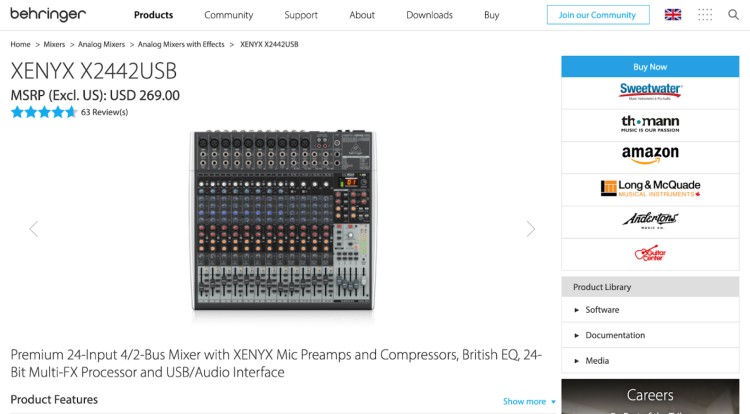
With five people, things get more complex but still doable. You’ll need an audio interface or mixer with at least 5 mic inputs (most likely 6+ to allow for flexibility) and enough headphone outputs.
Here’s a setup that can handle it:
- Behringer Xenyx X2442USB Mixer: Handles up to ten XLR mics with onboard compression and USB output.
- Five dynamic XLR mics: Use identical models to keep audio consistent across speakers.
- Five closed-back headphones: Isolate monitoring and reduce audio spill.
- Presonus HP60 headphone amp: Splits your signal cleanly across multiple listeners.
Space the mics in a circle or U-shape and keep gain low if your room isn’t treated. It’ll help avoid echo and mic bleed.
Podcast equipment for iPhone
Want to record a podcast from your iPhone? Here’s how to make it work:
- Shure MV88+ Video Kit: A compact condenser mic that plugs straight into your iPhone and comes with a mini tripod. Crisp sound, and it even includes an app for fine-tuning EQ and gain.
- Lightning-to-headphone adapter: If your iPhone doesn’t have a headphone jack, you’ll need this to monitor in real-time.
- Backpack Studio app: Simple, reliable mobile recording with sound pad support and multitrack capability.
- Portable lighting ring: If you’re filming video too, clip-on lighting keeps your face clear and shadows minimal.
Podcast equipment for Mac
MacOS handles audio well, and most podcast tools work natively without installing extra drivers. If you want a reliable setup, here’s how to build around your Mac.
- Apogee HypeMiC: Studio-quality USB mic with built-in analog compression. Works straight out of the box with GarageBand or Logic. Great if you want polished sound without extra gear.
- GarageBand: Already installed on your Mac. It’s more than enough to record, edit, and add music to your podcast.
- Closed-back headphones with flat response: Something like the Beyerdynamic DT 240 Pro gives you accurate monitoring without leaking audio into your mic.
- Adjustable boom arm: Keeps your mic off the desk and in the right position without picking up every bump and keystroke.
Podcast equipment for MacBook
MacBooks are great for portable recording, as long as your setup stays lean and efficient.
- Fifine K688 USB/XLR mic: USB-C connection works natively on newer MacBooks; upgrade to XLR later if needed.
- USB-C hub with passthrough: Lets you plug in your mic, headphones, and charger all at once.
- Ocenaudio: Lightweight, beginner-friendly editing software that runs well on limited memory.
- Felt desk mat: Adds quiet stability to your portable setup. No desk rattle, no mic bumps.
Easy to carry. Quick to set up. Clean enough to sound pro from anywhere with a door.
Your First Episode’s Closer Than You Think
The right podcast equipment for beginners gets you sounding sharp from day one, but gear alone won’t grow your brand.
If you want listeners to become leads (and clients), you need to get in front of the right audiences.
That’s where Talks comes in.
We help coaches, creators, and experts get booked on podcasts their dream clients already listen to.
Create your free Talks creator profile now and start turning your podcast into a powerful marketing engine.
